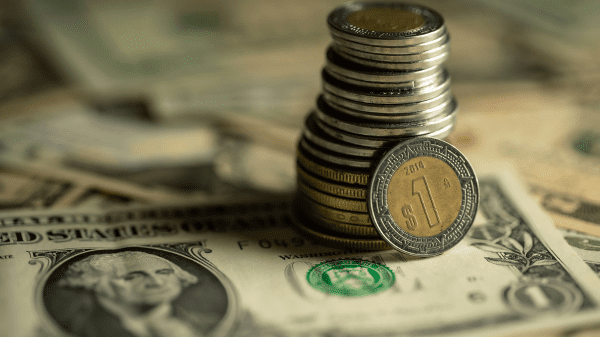The Mexican peso has soared in value relative to the U.S. dollar over the past year—24 percent.
On July 14, the exchange rate was 16.73 pesos to the dollar.
Strength, we normally think, is good; weakness is bad. This is not entirely the case for currencies. The stronger your currency is (that is, the higher its value relative to another currency), the more items you can buy from abroad, so that’s good. On the other hand, products you sell abroad are more expensive, which isn’t good.

The converse: the weaker your currency is, the fewer goods you can buy from abroad, but the price of your products is comparatively lower, so theoretically you can sell more.
But if your currency is too strong, it can stifle your export trade.
That hasn’t happened for Mexico yet: in fact, it has overtaken China as the top exporter to the United States over the past year; bilateral trade was at $263 billion in the first four months of this year. One explanation is nearshoring: bringing manufactures closer to home (Mexico versus Asia). Manufactured goods account for 90 percent of trade value.
As for the superpeso, “viewed with a longer-term perspective, my personal opinion is that this is a very good macrotrend for Mexico, as long as the peso doesn’t move too far too fast,” says Travis Bembenek, CEO of Mexico News Daily. “Economic stability brings investor confidence, as well as growth and prosperity through better infrastructure, better schools, better healthcare, and higher standards of living.”
But currency strength is very much a matter of winners and losers. One set of Mexicans put at a disadvantage are those depending on remittances (money sent back to them from relatives working in the U.S.). A weaker dollar buys fewer pesos, which can cause problems, particularly in states where remittances are high, such as Michoacán, Guanajuato, Jalisco, and Chiapas.
And of course, we have to consider the produce sector. Exporters of fruits and vegetables to the United States will get fewer pesos for their produce.
So far, this doesn’t seem to be a huge concern. Lance Jungmeyer, president of the Fresh Produce Association of the Americas BB #:144354, observes that with the strong peso, “the cost of inputs may decrease, because most farm inputs are sold based on dollar terms.”
That is, American equipment and agrichemicals will be cheaper, providing some economic advantage to Mexican producers.
At the same time, Mexican exports to this country are projected to continue to increase. One study from Texas A&M University estimates that, “based on conservative assumptions,” by 2030, U.S. fresh produce imports from Mexico will increase by 29.2 percent over 2022 levels.
For Mexican companies who export produce to the U.S., then, it would appear at present that the superpeso will help more than hurt.
The long-term forecasts suggest that the peso will continue to build its current strength. The Economic Forecast Agency expects that the exchange rate against the dollar will fall into the 13-peso range by 2026-27.



